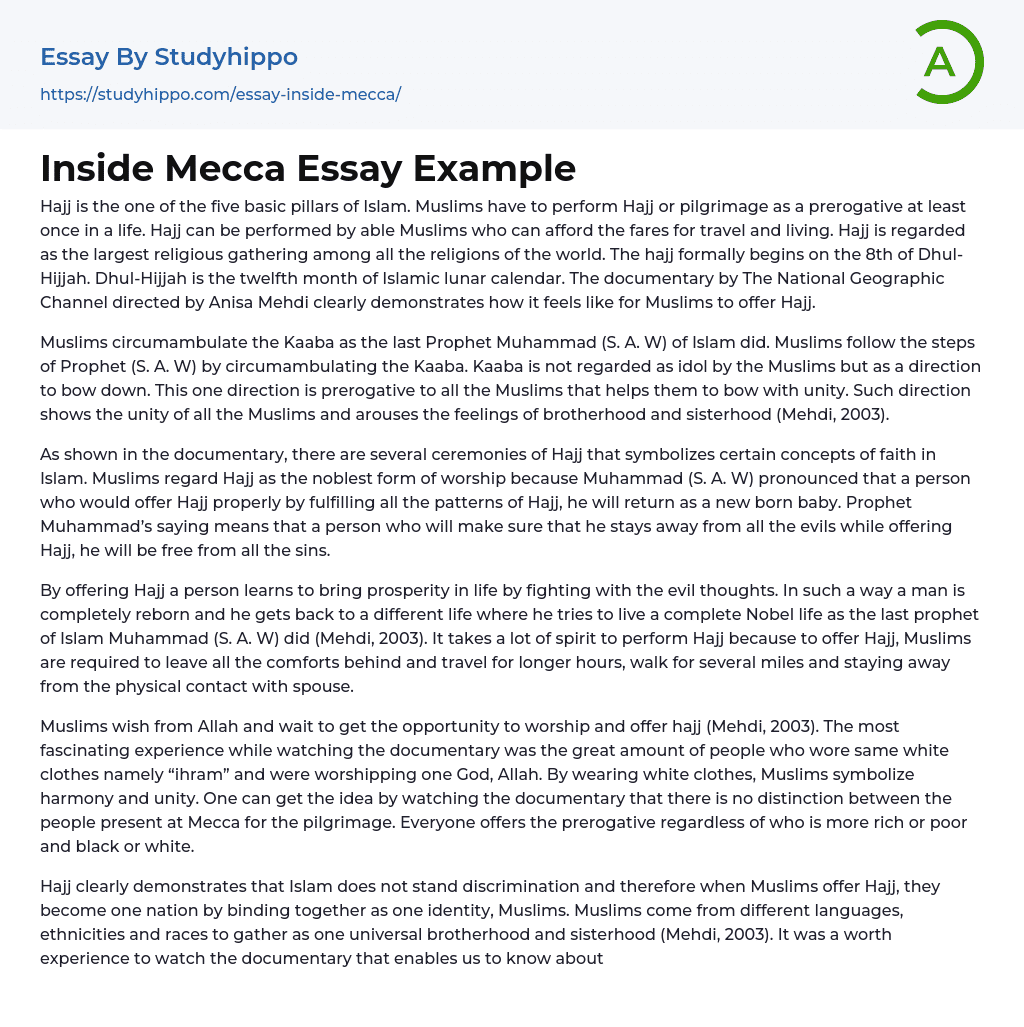Hajj is the one of the five basic pillars of Islam. Muslims have to perform Hajj or pilgrimage as a prerogative at least once in a life. Hajj can be performed by able Muslims who can afford the fares for travel and living. Hajj is regarded as the largest religious gathering among all the religions of the world. The hajj formally begins on the 8th of Dhul-Hijjah. Dhul-Hijjah is the twelfth month of Islamic lunar calendar. The documentary by The National Geographic Channel directed by Anisa Mehdi clearly demonstrates how it feels like for Muslims to offer Hajj.
Muslims circumambulate the Kaaba as the last Prophet Muhammad (S. A. W) of Islam did. Muslims follow the steps of Prophet (S. A. W) by circumambulating the Kaaba. Kaaba is not regarded as idol by the Mus
...lims but as a direction to bow down. This one direction is prerogative to all the Muslims that helps them to bow with unity. Such direction shows the unity of all the Muslims and arouses the feelings of brotherhood and sisterhood (Mehdi, 2003).
As shown in the documentary, there are several ceremonies of Hajj that symbolizes certain concepts of faith in Islam. Muslims regard Hajj as the noblest form of worship because Muhammad (S. A. W) pronounced that a person who would offer Hajj properly by fulfilling all the patterns of Hajj, he will return as a new born baby. Prophet Muhammad’s saying means that a person who will make sure that he stays away from all the evils while offering Hajj, he will be free from all the sins.
By offering Hajj a person learns
to bring prosperity in life by fighting with the evil thoughts. In such a way a man is completely reborn and he gets back to a different life where he tries to live a complete Nobel life as the last prophet of Islam Muhammad (S. A. W) did (Mehdi, 2003). It takes a lot of spirit to perform Hajj because to offer Hajj, Muslims are required to leave all the comforts behind and travel for longer hours, walk for several miles and staying away from the physical contact with spouse.
Muslims wish from Allah and wait to get the opportunity to worship and offer hajj (Mehdi, 2003). The most fascinating experience while watching the documentary was the great amount of people who wore same white clothes namely “ihram” and were worshipping one God, Allah. By wearing white clothes, Muslims symbolize harmony and unity. One can get the idea by watching the documentary that there is no distinction between the people present at Mecca for the pilgrimage. Everyone offers the prerogative regardless of who is more rich or poor and black or white.
Hajj clearly demonstrates that Islam does not stand discrimination and therefore when Muslims offer Hajj, they become one nation by binding together as one identity, Muslims. Muslims come from different languages, ethnicities and races to gather as one universal brotherhood and sisterhood (Mehdi, 2003). It was a worth experience to watch the documentary that enables us to know about how does religion matter in lives of people who are determined to follow their religion. That’s what the documentary displays regarding the Hajj and Muslims.




